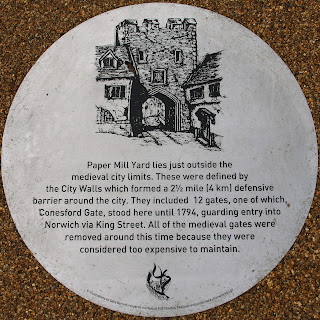The 'hostilities' bit of the Civil Wars pretty much passed the County of Norfolk by: not a great deal of fighting happened here. Norfolk's role was primarily as a recruiting ground, and bank roller of the Eastern Association. That's not to say that 'nothing' happened here, or that the county was solely for Parliament's cause.
Norwich's defences were bolstered, and a small garrison was established. Conesford, St Giles, Pockthorpe and St Augustine’s Gates were all blocked as part of these precautions. The gates have long been demolished but a number of markers exist documenting their locations.
The best way to locate the walls, and gates is by downloading the walls trail leaflet here.
Norwich Cathedral was damaged by an anti-Papist mob, and was later used as barracks.
Not all of Norfolk was for the Parliamentarian cause. In March 1643, Oliver Cromwell was sent to
King's Lynn to investigate rumours of a Royalist conspiracy. These rumours were unfounded, but just a few months later there was a Royalist coup and Sir Hamon L’Estrange was installed as governor. Initially Parliament's response was underwhelming: a fleet commanded by Robert Rich, Earl of Warwick, was sent into The Wash to cut the town off from the sea. Manchester initially decided that a blockade would suffice.
Once the Eastern Association became aware of just how well defended the town was, Manchester marched with the Association to besiege the town. Artillery batteries were established and the river was diverted to cut off the town's water supply. Manchester let it be known that he planned to take the town and that women and children would be allowed to leave. His threat worked and the town surrendered.
There are a number of sections of defensive earthworks that survive. The best section is in the Walks Park, close to Red Mount Chapel.
 |
| panoramic shot of the earthworks: the path is on the top of the earthworks, the ditch is now the water course |
Channel 4's Great British Dig Series has an episode looking at the King's Lynn defences (series 3 episode 3) which can be viewed via their
All4 service. If you can't access All4 you can find out more on
David Flintham's site.
Marriott's Warehouse has a cannonball on display, that is believed to date from the siege.
Great Yarmouth had a large garrison after the Second Civil War. The town's MP, Miles Corbet being the last of the fifty nine signatories of Charles's death warrant. He lived at 68 Market Place. After the Restoration, Miles fled to the Netherlands. He would be kidnapped and returned to England where he was hung, drawn and quartered at Tyburn on 19 April 1662.
The Elizabethan House Museum is run by Norfolk Museums on behalf of the National Trust. The House was owned by Benjamin Cowper, a close friend of Oliver Cromwell (who visited the house many times). The premises became a regular meeting place for Parliamentarians and it is here, allegedly, in November 1648 that the fate of Charles I was decided.
Regular readers (hello all eight of you) will know that I am a sucker for a moated manor house: Oxburgh Hall was built in the early fifteenth century. Oxburgh's owner, Royalist (and Catholic) Sir Henry Bedingfeld was captured by Parliamentary forces after Marston Moor.
He would be imprisoned in the Tower of London. His lands were confiscated and the Hall was ransacked; the East Range was gutted by fire. Oxburgh is now cared for by the National Trust.
 |
Oxburgh had the builders in when I visited. Hidden behind the scaffolding (on the right of the picture) is a visible join between original pre-fire Hall and the rebuilt East Range. During the works conservators discovered how close the whole house came to being lost to the fire, as the roof beams show extensive burning.
If you have access to Discovery+, 'Nick Knowles Heritage Rescue' series 2 episode 1 looks at how the National Trust have restored the building (and some of the things that they found whilst undergoing the work).
St Nicholas' Church in North Walsham is interesting for many reasons: most obviously the collapsed tower. But venture inside and you will find a thrice used armorial. Originally bearing the coat of arms of Charles I these were painted over with the Commonwealth state arms; then on one side Charles II's coat of arms were added after the Restoration. I must confess that I am very surprised to see that the Commonwealth state arms were left intact.
|
Postcodes for SatNavsNorwich Cathedral, The Close, Norwich NR1 4DH
Marriotts' Warehouse, South Quay, King's Lynn PE30 5DT
Red Mount Chapel/The Walks, South St, King's Lynn PE30 5ER
Elizabethan House Museum, South Quay, Great Yarmouth, NR30 2QHCorbet's House, Market Place, Great Yarmoth NR30 1ND
Oxburgh Hall, near Swaffham PE33 9PS
St Nicholas Church, North Walsham NR28 9BT
If you enjoyed reading this, or any of the other posts, please consider supporting the blog. Thanks.





.JPG)













Excellent as ever. I was in Norfolk just last month. If only I'd known....next time!
ReplyDeleteThanks, and sorry about the timing!
DeleteMaking a deliberate trip to King's Lynn today. Ostensibly shopping. Going to see the earthworks. Not told the missus that bit yet...
ReplyDeleteWasn't sure I should publish this comment Dex. You're leaving a paper trail of your plans and machinations. Of course, you could just say "oh look... didn't know that was there. Can we just...?"
DeleteIt actually turned out to be a good day. We also visited the King's Lynn museum which, from the perspective of our period, was pretty pants. Usual odd bit of armour and a portrait of Charlie I in a single display case.
DeleteI didn't have time to pop into the museum, thanks for the info - will add it in to the entry as soon as I get a chance
Delete